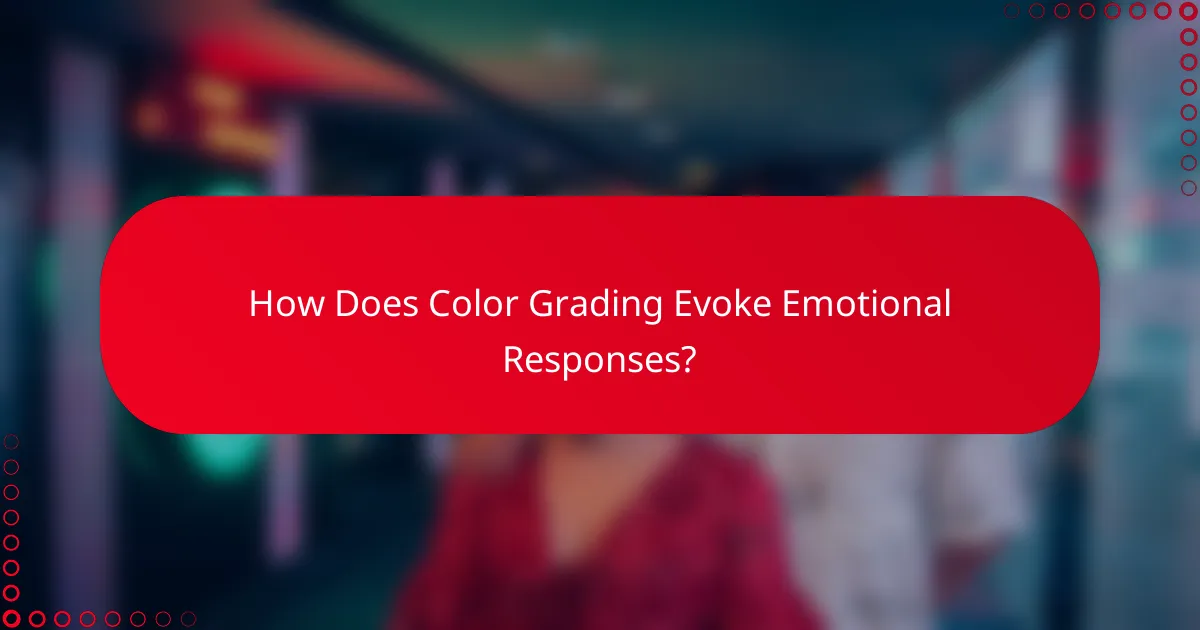Color grading is the process of adjusting colors in film and video to achieve a specific aesthetic, enhancing visual storytelling through manipulation of color balance, contrast, and saturation. This technique plays a vital role in post-production, influencing audience emotions and establishing a film’s unique style. Iconic films utilize color grading to deepen narrative impact and maintain visual consistency. Essential tools for color grading include DaVinci Resolve, Adobe Premiere Pro, and Final Cut Pro, each offering distinct features that cater to different editing workflows. The article explores various color grading techniques, their emotional resonance, and notable examples from acclaimed films.

What is Color Grading and Why is it Important?
Color grading is the process of adjusting the colors in a film or video to achieve a desired aesthetic. It enhances visual storytelling by manipulating color balance, contrast, and saturation. This technique creates mood and atmosphere, influencing the audience’s emotional response. For instance, warmer tones can evoke feelings of comfort, while cooler tones may create tension. Color grading is crucial in post-production, as it helps maintain visual consistency across scenes. It also allows filmmakers to establish a unique style, making their work more recognizable. Iconic films often use color grading to enhance narrative depth and visual appeal, solidifying its importance in the filmmaking process.
How does Color Grading Influence Visual Storytelling?
Color grading significantly influences visual storytelling by shaping the mood and tone of a film. It alters colors to evoke specific emotions in the audience. For example, warm tones can create feelings of comfort or nostalgia. In contrast, cool tones often induce sadness or tension.
Studies show that color can affect viewer perception and emotional response. Research by the University of California found that colors can influence memory retention and emotional engagement. This demonstrates the power of color grading in narrative contexts.
Directors and cinematographers use color grading to enhance character development and thematic elements. For instance, a character’s arc may be visually represented through changing color palettes. This technique deepens audience connection to the story.
In iconic films, such as “The Grand Budapest Hotel,” color grading is pivotal in establishing a whimsical yet melancholic atmosphere. The film’s vibrant color scheme contrasts with its somber themes, highlighting the complexity of the narrative.
Overall, color grading is an essential tool in visual storytelling, impacting audience emotions and enhancing narrative depth.
What are the key principles of Color Grading?
The key principles of color grading include contrast, saturation, color balance, and mood. Contrast refers to the difference between the lightest and darkest areas of an image. High contrast can create drama, while low contrast gives a softer look. Saturation determines the intensity of colors. Highly saturated colors are vibrant, while desaturated colors appear muted. Color balance involves adjusting the colors to achieve a natural look or a specific effect. This can affect the overall tone of the image. Mood is established through color choices. Warm colors can evoke feelings of comfort, while cool colors can create a sense of calm or detachment. These principles work together to enhance storytelling in visual media.
How does Color Grading affect audience perception?
Color grading significantly affects audience perception by influencing emotions and storytelling. It alters the mood of a scene through color palettes. For instance, warm tones can evoke feelings of comfort or nostalgia. Conversely, cool tones often create a sense of tension or unease. Research indicates that color can impact viewer engagement and emotional response. A study by the University of California found that specific colors can trigger psychological associations. For example, red is often linked to passion or danger, while blue is associated with calmness. This psychological impact shapes how audiences interpret narratives and characters. Thus, effective color grading enhances storytelling by guiding viewer emotions and perceptions.
What Techniques are Used in Color Grading?
Color grading techniques include color correction, color enhancement, and color stylization. Color correction adjusts the overall balance and exposure of the footage. This technique ensures consistency across shots. Color enhancement focuses on making certain colors more vivid without altering the overall look. This technique can bring attention to specific elements in a scene. Color stylization applies creative color palettes to evoke specific moods or themes. This technique is often used to create a unique visual identity for a film. Other techniques include using LUTs (Look-Up Tables) and secondary color correction. LUTs provide a quick way to achieve a specific look. Secondary color correction allows for adjustments to specific colors without affecting the entire image. These techniques collectively enhance the visual storytelling of a film.
What are the different types of Color Grading techniques?
There are several types of color grading techniques used in film and photography. These techniques include primary color correction, secondary color correction, and creative color grading. Primary color correction adjusts the overall color balance and exposure of the image. It ensures that the colors are accurate and consistent throughout the footage. Secondary color correction targets specific colors within the image. This allows for more precise adjustments without affecting the entire image. Creative color grading is used to establish a specific mood or aesthetic. It often involves stylized color palettes that enhance the emotional impact of the scene. Each technique plays a crucial role in the final look of a project.
How do these techniques vary by genre or style?
Color grading techniques vary significantly by genre and style. In horror films, dark and desaturated colors create tension and unease. Conversely, comedies often use bright, vibrant colors to evoke joy and humor. Action films typically feature high-contrast grading to enhance excitement and intensity. Dramatic films may employ muted tones to convey seriousness and emotional depth.
Animated films often use bold and exaggerated color palettes to appeal to younger audiences. Documentaries frequently utilize natural color grading to maintain authenticity and realism. Each genre adapts color grading to align with its narrative and emotional objectives, demonstrating the integral role of color in storytelling.

How Does Color Grading Evoke Emotional Responses?
Color grading evokes emotional responses by manipulating the hues, saturation, and contrast of visual content. Different colors are associated with specific emotions; for example, blue often conveys sadness while red can evoke passion or anger. This psychological effect is rooted in color theory, which suggests that colors can influence mood and perception. Studies show that audiences respond differently to scenes based on their color palettes. For instance, a warm color palette can create a sense of comfort, while cooler tones may induce feelings of isolation. Films like “The Grand Budapest Hotel” use distinctive color grading to enhance storytelling and emotional depth. The strategic use of color can make scenes more impactful and memorable, guiding audience reactions effectively.
What role does Color Grading play in setting the mood?
Color grading plays a crucial role in setting the mood of visual media. It enhances emotional impact by manipulating colors to evoke specific feelings. For example, warm tones can create a sense of comfort or nostalgia. In contrast, cooler tones often convey sadness or detachment. Studies have shown that color influences perception and emotional response. Research indicates that viewers associate certain colors with specific emotions. For instance, red can signify passion or danger, while blue often represents calmness. Thus, effective color grading aligns visual elements with narrative intentions. This alignment helps audiences connect more deeply with the story being told.
How can specific colors influence viewer emotions?
Specific colors can significantly influence viewer emotions through psychological associations. For example, red often evokes feelings of passion or urgency. Blue typically conveys calmness and tranquility. Yellow is associated with happiness and energy. Green often represents nature and can induce feelings of peace.
Research by Andrew Elliot and Markus Maier in “Color and Psychological Functioning: A Review of Theoretical and Empirical Work” supports these associations. Their findings demonstrate that color can affect mood and behavior. The emotional responses to colors are often culturally influenced but share commonalities across different societies.
In film and visual media, color grading is strategically used to enhance emotional impact. For instance, warm colors can create an inviting atmosphere, while cool colors may evoke sadness or detachment. Thus, the strategic use of color is essential in shaping viewer emotions.
What are examples of successful emotional Color Grading?
Successful emotional color grading examples include “The Matrix,” “The Grand Budapest Hotel,” and “Moonlight.” In “The Matrix,” green hues convey a sense of artificiality and control. “The Grand Budapest Hotel” uses vibrant pastels to evoke nostalgia and whimsy. “Moonlight” employs deep blues and warm skin tones to reflect intimacy and vulnerability. Each film’s color palette enhances the narrative and emotional depth. These choices impact audience perception and engagement significantly.
How do Iconic Films Utilize Color Grading?
Iconic films utilize color grading to enhance visual storytelling and evoke emotions. Color grading adjusts the hues, saturation, and brightness of footage. This technique creates a specific mood or atmosphere. For example, “The Godfather” uses warm tones to convey intimacy and nostalgia. In contrast, “Mad Max: Fury Road” employs high contrast and saturated colors to amplify chaos and intensity. The choice of color palette influences audience perception and engagement. Studies show that color can affect emotional responses, reinforcing narrative themes. Iconic films strategically apply color grading to establish identity and enhance cinematic experience.
What are some landmark films known for their Color Grading?
Some landmark films known for their color grading include “The Matrix,” “Mad Max: Fury Road,” and “Blade Runner 2049.” “The Matrix” utilized a green tint to create a distinctive visual style that enhances its cyberpunk aesthetic. “Mad Max: Fury Road” employed vibrant colors to emphasize action and chaos, making it visually striking. “Blade Runner 2049” featured a carefully crafted palette that reflects its dystopian themes and emotional depth. Each of these films demonstrates the powerful impact of color grading on storytelling and visual appeal.
How has Color Grading evolved in cinema over the years?
Color grading in cinema has evolved significantly from its early days to the present. Initially, films were graded using physical techniques like hand-painted frames and filters. This process was time-consuming and limited in scope. With the advent of digital technology, color grading became more sophisticated. The introduction of non-linear editing systems in the 1990s allowed for greater flexibility and precision. Software like DaVinci Resolve revolutionized the field by providing advanced tools for color correction and grading. Modern filmmakers now use color grading to enhance storytelling and evoke emotions. For instance, films like “Mad Max: Fury Road” and “The Grand Budapest Hotel” showcase distinctive color palettes that contribute to their narratives. Today, color grading is an essential part of the post-production process, shaping the visual identity of films.

What Tools and Software are Essential for Color Grading?
Essential tools and software for color grading include DaVinci Resolve, Adobe Premiere Pro, and Final Cut Pro. DaVinci Resolve is widely regarded for its advanced color correction capabilities. Adobe Premiere Pro integrates well with other Adobe products and offers solid color grading tools. Final Cut Pro is favored by many Mac users for its intuitive interface and robust features. These programs enable editors to manipulate color, contrast, and saturation effectively. Professional filmmakers and video editors commonly use these tools to enhance visual storytelling. Each software provides unique features tailored for different workflows and preferences.
What are the most popular Color Grading software options?
The most popular color grading software options include DaVinci Resolve, Adobe Premiere Pro, and Final Cut Pro. DaVinci Resolve is renowned for its advanced color correction tools and is widely used in the film industry. Adobe Premiere Pro offers robust editing features along with integrated color grading capabilities. Final Cut Pro is favored by Mac users for its user-friendly interface and powerful color grading tools. These software options are frequently utilized by professionals for their versatility and comprehensive features in color grading.
How do these tools differ in functionality and ease of use?
Different color grading tools vary significantly in functionality and ease of use. For instance, Adobe Premiere Pro offers a comprehensive suite of features for professional-grade color correction. It includes advanced color wheels and curves, allowing for precise adjustments. In contrast, tools like DaVinci Resolve are known for their powerful color grading capabilities and extensive options for color manipulation. However, they can have a steeper learning curve due to their complexity.
Ease of use also varies widely. Premiere Pro is user-friendly for beginners, thanks to its intuitive interface. DaVinci Resolve, while powerful, may require more time to master. This difference in user experience can influence a user’s choice based on their skill level and project requirements. Overall, functionality and ease of use are key differentiators among color grading tools.
What Best Practices Should be Followed in Color Grading?
Best practices in color grading involve maintaining consistency, understanding color theory, and using professional tools. Consistency ensures that the color grading aligns with the overall narrative and style of the film. Understanding color theory helps in selecting hues that evoke the desired emotions. Professional tools like DaVinci Resolve or Adobe Premiere Pro provide advanced features for precise adjustments. Additionally, working in a controlled environment with proper lighting is crucial for accurate color perception. Regularly referencing the original footage during grading helps maintain fidelity to the source material. Finally, collaborating with the director and cinematographer ensures that the color grading aligns with their vision. These practices enhance the visual storytelling of the film.
How can filmmakers ensure consistency in Color Grading?
Filmmakers can ensure consistency in color grading by using a defined color palette throughout the project. Establishing a color reference guide aids in maintaining uniformity across scenes. Utilizing color grading software with preset options can streamline the process. Regularly comparing shots side by side helps identify discrepancies. Employing scopes and monitors for accurate color representation is essential. Consistent lighting during filming also contributes to uniform color grading. Collaborating closely with the cinematographer ensures alignment on the visual style. Following these practices can lead to a cohesive look in the final product.
What common mistakes should be avoided in Color Grading?
Common mistakes to avoid in color grading include over-saturation, which can make footage look unnatural. Inconsistent color balance is another issue, leading to distracting variations in scenes. Neglecting to consider the emotional tone can result in a mismatch between visuals and narrative. Failing to use scopes for monitoring can lead to inaccurate adjustments. Lastly, not saving different versions can hinder progress and experimentation. These mistakes can compromise the overall quality of the final product.
What Resources are Available for Learning Color Grading Techniques?
Online courses are available for learning color grading techniques. Platforms like Udemy and Coursera offer structured lessons. These courses cover software like DaVinci Resolve and Adobe Premiere Pro. YouTube hosts numerous tutorials from industry professionals. Books on color theory and grading techniques provide in-depth knowledge. Websites like No Film School feature articles and guides on color grading. Forums and communities like Reddit’s r/Filmmakers allow for peer learning and advice. Professional workshops and seminars also offer hands-on experience and networking opportunities.
What online courses or tutorials are highly recommended?
Highly recommended online courses for color grading include “Color Grading in DaVinci Resolve” on Udemy. This course covers essential techniques for color correction and grading. “The Art of Color Grading” on Skillshare is another top choice. It focuses on emotional impact through color choices in film. Additionally, “Advanced Color Grading Techniques” from LinkedIn Learning provides in-depth tutorials for experienced users. Each course offers practical projects to enhance skills. These platforms have thousands of positive reviews, reflecting their effectiveness in teaching color grading.
How can aspiring colorists build a portfolio effectively?
Aspiring colorists can build a portfolio effectively by showcasing a diverse range of projects. They should include before-and-after shots to highlight their skills. Collaborating with filmmakers on short films or music videos provides practical experience. Participating in online challenges or contests can also enhance visibility. Engaging in personal projects allows for creative freedom and experimentation. Networking with industry professionals can lead to mentorship opportunities. Utilizing social media platforms helps in reaching a broader audience. Consistently updating the portfolio with new work demonstrates growth and skill development.
Color grading is the process of adjusting colors in film and video to enhance visual storytelling and evoke emotional responses. This article explores the significance of color grading, including its impact on mood, audience perception, and narrative depth. Key principles such as contrast, saturation, and color balance are discussed, along with various techniques used across different genres. Additionally, the article highlights landmark films known for their effective use of color grading and provides insights into essential tools and best practices for filmmakers. Resources for learning color grading techniques and building a professional portfolio are also outlined.